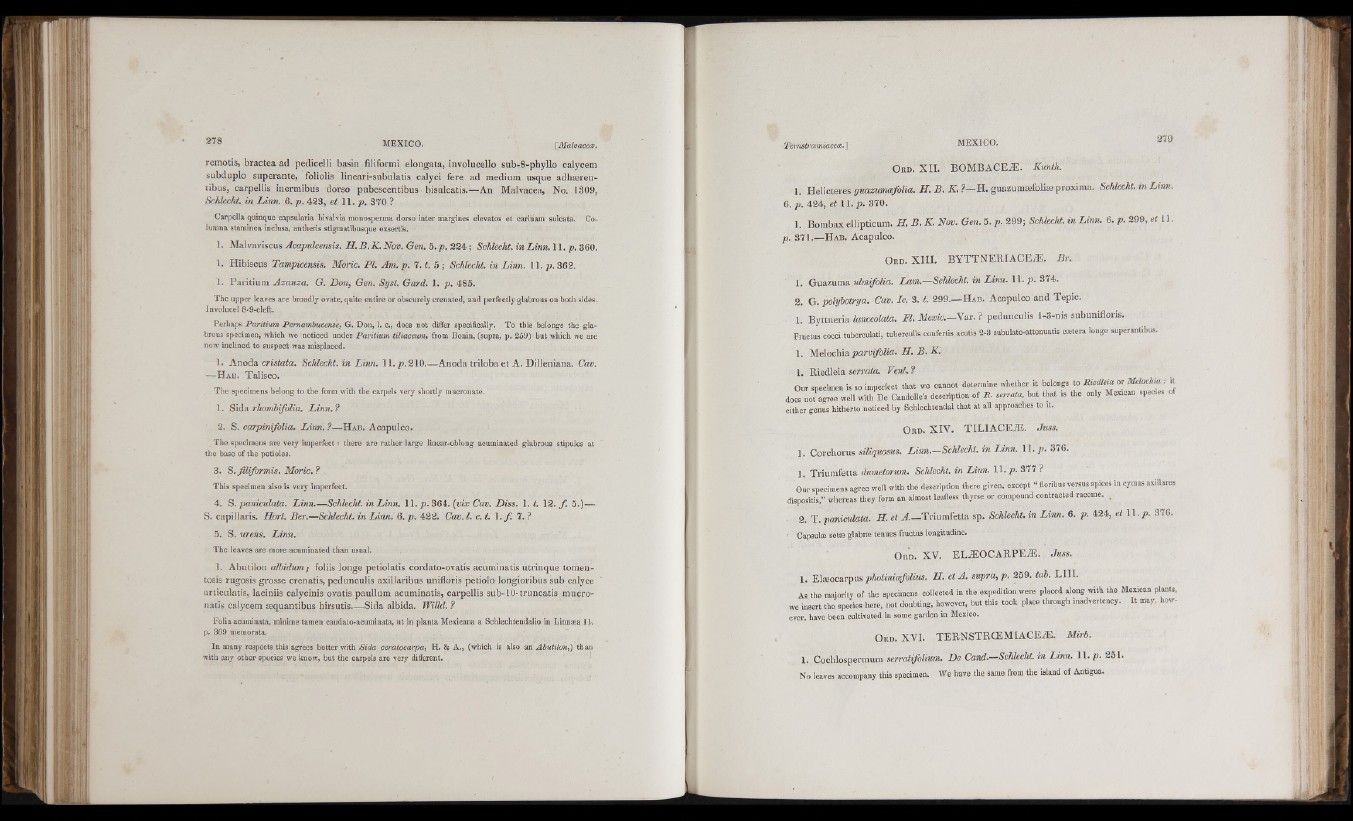
remotis, bractea ad pedicelli basin filiformi elongata, involucello sub-8-phyllo calycem
subduplo superante, foliolis lineari-subulatis calyci fere ad medium usque adliæren-
tibus, carpellis inermibus dorso pubescentibus bisulcatis.— An Malvacea, No. 1309,
Schlecht. in L in n . 6. p . 423, et 11. p . 370 ?
Carjiella quinque capsularia bivalvia monosperma dorso inter margines elevatos et carinam sulcata. Columna
staminea inclusa, antheris stigmatibusque exsertis.
1. Malvaviscus H .B .K .N o v .G e n .b .p .2 2 4 - , Schlecht. in L in n .W . p.ZOO.
1. Hibiscus Tampicensis. Morie. P l. Am. p . 7. i. 5 ; Schlecht. in L in n . 1 L p . 362.
J. P a ritium A za n za . G. Don, Gen. Syst. Gard. J. p . 485.
The upper leaves are broadly ovate, quite entire or obscurely crenated, and perfectly glabrous on both sides.
Involucel 8-9-cleft.
Perhaps Paritium Pernambucense, G. Don, 1. c., does not differ specifically. To this belongs the glabrous
specimen, which we noticed under Paritium tiliaceum, from Bonin, (supra, p. 259) but which we are
now inclined to suspect was misplaced.
1. Anoda cristata. Schlecht. in Lin n . 11. /j. 210.— Anoda triloba et A. Dilleniana. Cav.
— H a b . Talisco.
The specimens belong to the form with the carpels very shortly mucronate.
1. S\da rhombifolia. L in n ,?
2. S. carpinifolia. L in n . ?— H a b . Acapulco.
The specimens are very imperfect : there are rather large linear-oblong acuminated glabrous stipules at
the base of the petioles.
3. S i.flifo rm is . M o rie .?
This specimen also is very imperfect.
4. S. paniculata. L in n .— Schlecht. in L in n . 11. p . 364. {vix Cav. Diss. 1. t. 12. / . 5 .)—
S. capillaris. Hort. Ber.—Schlecht. in L in n . 6. p . 422. Cav. I. c .t. \ . f . 7. ?
5. S. urens. L in n .
The leaves are more acuminated than usual.
1. Ah a \\\o n albidum ; foliis longe petiolatis cordato-ovatis acuminatis u trin q u e tom en tosis
rugosis grosse crenatis, pedunculis axillaribus unifloris petiolo longioribus sub calyce
articulatis, laciniis calycinis ovatis paullum acuminatis, carpellis sub-10-truncatÌs mucronatis
calycem æquantibus hirsutis.— Sida albida. Willd. ?
Folia acuminata, minimetamen caudalo-acuminata, ut in planta Mexicana a Schlechtendalio in Linnæa II.
p. 369 memorata.
In many respects this agrees better with Sida ceratocarpa, H. & A., (which is also an Abutilon,) than
with any other species we know, but the carpels are very different.
O k d . X I I . B O M B A C EÆ . Kunth.
H . B . K , H . guazutnoefoliæ p róxima.1. Helicteres guaz Schlecht. in Lin n .
6. p . 484, « i l l . p . 370.
1. Bombax ellipticum. H . B . K. Nov. Gen. 5. p . 299; Schlecht. in L in n . 6. p . 299, ei 11.
p . 37 1 H a d . Acapulco.
O k d . X I I I . B Y T T N E R IA C EÆ . B r .
1. Guazuma ulmifolia. L am .— Schlecht. in L in n . 11. p . 374.
2. G. polylotrya. Cav. Ic. 3. t. 299.— H a b . Acapulco and Tepic.
I. B yttneria lanceolata. F l. M e x i c .-Y a r . ? pedunculis 1-3-nis subunifloris.
Fructus cocci tuberoulati, tuberculis confertis acutis 2-3 subulato-atlenuatis cætcra longe superantibus.
1. Melochia parai/ofid. H . B .K .
1. Rtedleia serrata. Vent. ?
Our specimen is so impeitecl that we cannot determine whether it belongs 10 Riedkia or Melochia .- it
does not agree well with De Candolle's deseription of R . serrata, bnt that is the only Mexican species o
either genus hitherto noticed by Schlechtendal that at all approaches to it.
O e d . X IV . T IL IA C E Æ . Juss.
1. Corchorus siliquosus. L in n .— Schlecht. in L in n . 11. p . 376.
1. T rium fetta dumetorum. Schlecht. in Lin n . 1 1, p . 377 ?
Onr speciniens agree well with the description there given, except “ üoribns versus apices in cymas axillares
dispositis,'' whereas they form an almost leafless thyise or compound contracted raceme. ,
a. T . paniculata. H . et Æ—T rium fetta sp. Schlecht. in L in n . 6. p. 424, ei 11. p . 376.
Capsules setas glabræ tenues fructus longitudine.
O e d . XV . E L Æ O C A R P E Æ . Juss.
1. Elæocai-pus photinicefolius. H . et A. supra, p. 259. tab. L I I I .
As the maiority ot the specimens collected in the expedition were placed along with the Mexican plants,
we insert the species here, not doubting, however, but this took place through rnadvertency. It may, however,
have been cultivated in some garden in Mexico.
O r d . X V I. T E R N S T R OE M IA C E Æ . Mirb.
I. Cochlospermum serratifolium. De Cand.—Schlecht. in Lin n . 11. p . 251.
No leaves accompany this specimen. We have the same from the island of Andgua.
. i J l i